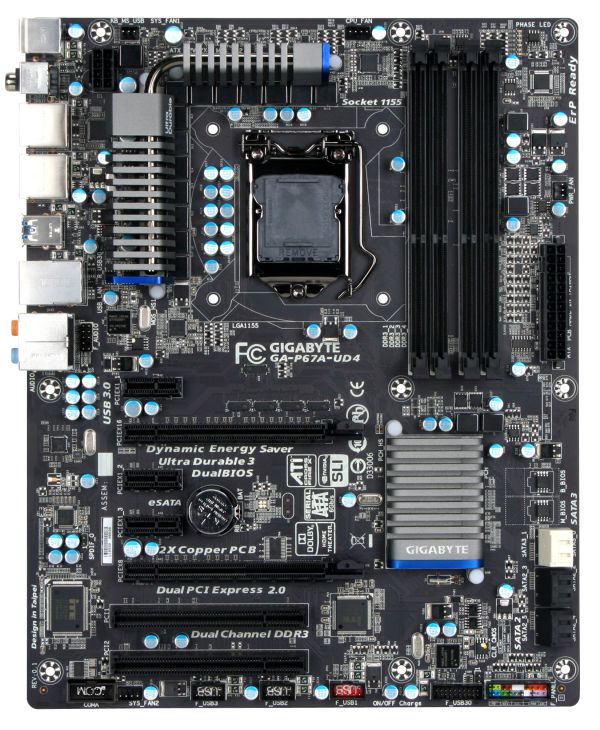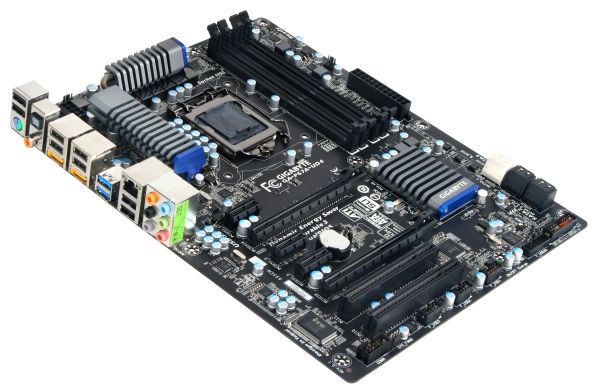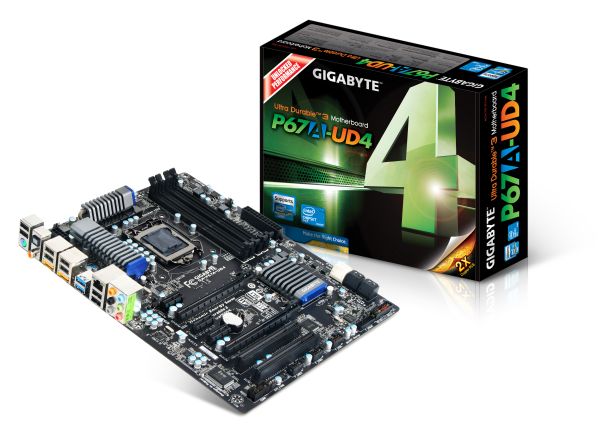The Battle of the P67 Boards - ASUS vs. Gigabyte at $190
by Ian Cutress on January 20, 2011 4:15 PM EST- Posted in
- Motherboards
- Gigabyte
- Asus
- P67
Gigabyte has five P67 motherboards up for the US Sandy Bridge release – the P67A-UD3, the P67A-UD3P, the P67A-UD4, the P67A-UD5 and the P67A-UD7. At least the naming scheme is as easy to follow as previous generations – the higher the last number, the more expensive the board and the more features on offer:
| P67A Series | |||||
| P67A-UD3 | P67A-UD3P | P67A-UD4 | P67A-UD5 | P67A-UD7 | |
| Price | $130 | $160 | $190 | $260 | $320 |
|
SATA 6 Gb/s SATA 3 Gb/s eSATA |
2 4 0 |
2 4 0 |
2 4 2 |
2 4 2 |
4 4 2 |
|
CrossFireX SLI |
Yes No |
Yes No |
Yes Yes |
Yes Yes |
Yes Yes |
|
USB 3.0 USB 2.0 |
2 12 |
4 14 |
4 14 |
8 10 |
10 8 |
| LAN | 1 | 1 | 1 | 1 | 2 |
| PCIe |
2 x16 (1 x16, 1 x4) |
2 x16 (1 x16, 1 x4) |
2 x16 (2 x8) |
3 x16 (2 x8, 1 x4) |
4 x16 (2 x16 or 4 x8) |
Visual Inspection
One of the first things I noticed about the P67A-UD4 was that it was not blue and white, like the majority of the Gigabyte motherboards have been recently that I have worked with. Predominantly featuring a black PCB, black PCIe connectors, black DIMM slots, black SATA 3Gb/s ports, a splash of white for SATA 6GB/s, silver chipset/FET coolers and a hint of old Gigabyte blue on those coolers is what we get this iteration. Not the whole range is like this – I have a H67 Gigabyte board on my desk here and that retains the blue and white credentials, as does the P67A-UD3.
The PCIe layout is slightly different to other P67 boards I have reviewed – with only two PCIe x16 slots (going to x8/x8 in dual GPU mode), there is an extra PCIe x1 slot on the board. In a dual GPU setup, this leaves two PCIe x1 and a PCI slot still free on the board, as well as a gap between dual slot GPUs to aid in cooling.
Fan headers on the board are located near the 8-pin power connector, one above the socket, one above the 24-pin power connector, and one below the PCIe slots, which would only be covered if you have a dual slot PCI card.
Gigabyte’s dual BIOS system is on this board. Yes, that is right – BIOS. No UEFI here. Well, that's not strictly true, as one of the latest BIOS updates at the time of writing (F6) implements an EFI into the BIOS, reportedly allowing bootable access to hard drives over 2.2TB. This is due to, as Gigabyte explained, that their board is actually UEFI, but without a proper GUI interface like other boards. They've used the old BIOS-style interface for now, as after years of plugging away they believe it's quick, stable and recognisable for consumers to understand. So underneath, it's truly 64-bit, meaning 2.2TB+ partition support is possible, and could also suggest that a new GUI is coming in the future. I asked about time-scale for this, but Gigabyte were undoubtedly tight-lipped about dates and implementations.
Visually, in terms of the board, there is not much else to say – the space between the socket and the PCI slots is virtually clear. There are no power, reset or clear CMOS buttons on board, neither is there a debug LED, and which is a real shame given that ASRock can do it on a $150 motherboard. Compared to the ASUS board, all the energy saving and turbo performance options are all software based – no easy flick of switches here.
Like the other P67 boards, the back panel is regular as well. Only a single PS/2 connector, 8 USB 2.0 ports, 2 USB 3.0 ports, 2 eSATA ports, S/PDIF Out connectors, a single gigabit Ethernet, and audio I/O.














137 Comments
View All Comments
IanCutress - Thursday, January 20, 2011 - link
Long term usability isn't something that's easily tested. Sleep and hibernate is simple to test, but leaving the board on for a week? We unfortunately a) do not have enough hardware to keep the mu;tiples of same test bed and test other products at the same time, and b) if something did go wrong after a long sleep state, how long it would take to get in a different BIOS and re-run the test, or if a new BIOS had been released during the test, the test would have to be restarted. It's not a case of this being ignored by review sites, it's just not an applicable use of time, effort, and sustainability. If this is a major concern to you, then I'd suggest holding back until the next revisions of these boards hit the shelves - by that point, issues would be worked out and there would be a plethora of threads on the vendor's website describing various long term usability issues. There are always niche situations which could be looked at in more detail, and if you're up to the task, join a review website or start your own to tackle these issues specifically.Ian
strikeback03 - Friday, January 21, 2011 - link
Not to say your experiences are isolated (as I have an ASUS board that doesn't like one peripheral when resuming from sleep) but Gigabyte boards can have problems as well. I built a system for work using a P45 Gigabyte board that cannot run for more than 4 days, it just locks up after that.scott967a - Thursday, January 20, 2011 - link
Could you throw an MSI board into the mix?VahnTitrio - Thursday, January 20, 2011 - link
I had to order that ASUS board with basically no reviews available. Looks like I made a solid choice, as I got it for $165. I'm hoping it's waiting for me when I get home from work.landerf - Thursday, January 20, 2011 - link
Does anyone have a break down of what usb/sata controllers each asus model uses?ValueDriven - Thursday, January 20, 2011 - link
Thank you for this article. For me very timely w.r.t. general sandy bridge and ASUS specifically.I recently grabbed an i5-2500K at Microcenter for $192 after-tax, and bundled with an ASUS P8P67 (not PRO, Crossfire only) for another $127 after-tax. For a total of $320. Now all I need is some DDR3 memory and I'll have the missing components for my new build (non-gamer). So for about $375-$400, I'll have for once the basis of a mid-level enthusiast build with the latest technology and over-clockable in the high 4-5GHz range. (I usually trail the technology, letting it "depreciate." Hence, ValueDriven.)
I've had mixed results, but generally good, with ASUS boards. Long ago I had an ASUS P2B-F (i486 I think, PENTIUM III - 750MHz) which seemed pretty good and lasted a long long time.
Next I had an ASUS A7N8X Deluxe (AMD Athlon) board which was OK, although it did finally fail. I only hated it relative to the ABIT NF-7S board I got for a 2nd setup which oc'd a lot better, taking my Athlon from a native 1460MHz up to about 2220MHz..
Most recently I have an ASUS P5 Deluxe WiFi-AP (with a Core2 Quad 6600) which I got on clearance when CompUSA folded (to become kids 'puter). I really can't complain about this board. In fact, it has been great. The only thing it hasn't done is oc my Q6600 as high as I'd like, but I believe this is the fault of my TUNIQ Tower120 which has a crappy mount (press fit screw retainer heads popped off during installation - requiring torch & hammer repair). If I keep this Q6600 setup, I'll probably install a new heatsink...maybe a SCYTHE Mugen 2 w/ double fans which is sitting in the closet. But then I need to get a cooler for the i5-2500k! :(
The only GIGABYTE board I have, a GA-EP45-UD3R, I have never used. I bought it and an INTEL Q9550 for a new build which I'm probably going to skip & resell the parts. But I did buy it b/c I had heard good things about this board. (Mugen was originally for this setup.)
SO for me the real question is: Is it better to keep the Sandy Bridge setup & part out either my unused Q9550 setup or my used Q6600 setup, OR is it better to return the Sandy Bridge and just build my Q9950? The jury is still out!
darckhart - Thursday, January 20, 2011 - link
It's not really value driven if you don't use the parts you buy... it's just a loss. that continues to depreciate.wrt your situation, move forward with the sandy bridge since you have it already. at 4.5+ GHz, and new board features like usb3 etc, it's already loads better than a q9550 oc and p45 chipset.
strikeback03 - Friday, January 21, 2011 - link
I'd have to check, but I believe that is the same processor and motherboard I referenced above. In which case I couldn't recommend it unless you naturally shut the computer down daily or similar. We have it set up next to a stock-clock Q6600/P35 system and the student using them says the Q9550 feels faster, that said if overclocking you probably won't be able to tell much of a difference and the newer parts would probably get you more money back. the i5 is going to be a lot faster.DaveSimmons - Thursday, January 20, 2011 - link
Do any of the three support Dolby Digital Live real-time encoding of game audio as 5.1 for the optical digital port?I'm using analog outs for my socket775 system but may be switching to optical digital for my next build.
ajp_anton - Thursday, January 20, 2011 - link
You should've benchmarked the LAN connection. Is there any difference between Intel and Realtek?